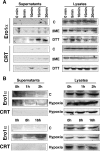Ero1alpha requires oxidizing and normoxic conditions to localize to the mitochondria-associated membrane (MAM)
- PMID: 20186508
- PMCID: PMC3006622
- DOI: 10.1007/s12192-010-0174-1
Ero1alpha requires oxidizing and normoxic conditions to localize to the mitochondria-associated membrane (MAM)
Abstract
Protein secretion from the endoplasmic reticulum (ER) requires the enzymatic activity of chaperones and oxidoreductases that fold polypeptides and form disulfide bonds within newly synthesized proteins. The best-characterized ER redox relay depends on the transfer of oxidizing equivalents from molecular oxygen through ER oxidoreductin 1 (Ero1) and protein disulfide isomerase to nascent polypeptides. The formation of disulfide bonds is, however, not the sole function of ER oxidoreductases, which are also important regulators of ER calcium homeostasis. Given the role of human Ero1alpha in the regulation of the calcium release by inositol 1,4,5-trisphosphate receptors during the onset of apoptosis, we hypothesized that Ero1alpha may have a redox-sensitive localization to specific domains of the ER. Our results show that within the ER, Ero1alpha is almost exclusively found on the mitochondria-associated membrane (MAM). The localization of Ero1alpha on the MAM is dependent on oxidizing conditions within the ER. Chemical reduction of the ER environment, but not ER stress in general leads to release of Ero1alpha from the MAM. In addition, the correct localization of Ero1alpha to the MAM also requires normoxic conditions, but not ongoing oxidative phosphorylation.
Figures





Similar articles
-
Ero1α regulates Ca(2+) fluxes at the endoplasmic reticulum-mitochondria interface (MAM).Antioxid Redox Signal. 2012 May 15;16(10):1077-87. doi: 10.1089/ars.2011.4004. Epub 2011 Oct 19. Antioxid Redox Signal. 2012. PMID: 21854214
-
ERO1α-dependent endoplasmic reticulum-mitochondrial calcium flux contributes to ER stress and mitochondrial permeabilization by procaspase-activating compound-1 (PAC-1).Cell Death Dis. 2013 Dec 19;4(12):e968. doi: 10.1038/cddis.2013.502. Cell Death Dis. 2013. PMID: 24357799 Free PMC article.
-
Oxidative protein folding in the endoplasmic reticulum: tight links to the mitochondria-associated membrane (MAM).Biochim Biophys Acta. 2010 Aug;1798(8):1465-73. doi: 10.1016/j.bbamem.2010.04.009. Epub 2010 Apr 27. Biochim Biophys Acta. 2010. PMID: 20430008 Free PMC article. Review.
-
Different interaction modes for protein-disulfide isomerase (PDI) as an efficient regulator and a specific substrate of endoplasmic reticulum oxidoreductin-1α (Ero1α).J Biol Chem. 2014 Nov 7;289(45):31188-99. doi: 10.1074/jbc.M114.602961. Epub 2014 Sep 25. J Biol Chem. 2014. PMID: 25258311 Free PMC article.
-
The physiological functions of mammalian endoplasmic oxidoreductin 1: on disulfides and more.Antioxid Redox Signal. 2012 May 15;16(10):1109-18. doi: 10.1089/ars.2011.4475. Epub 2012 Feb 15. Antioxid Redox Signal. 2012. PMID: 22220984 Review.
Cited by
-
Urban planning of the endoplasmic reticulum (ER): how diverse mechanisms segregate the many functions of the ER.Biochim Biophys Acta. 2011 Oct;1813(10):1893-905. doi: 10.1016/j.bbamcr.2011.06.011. Epub 2011 Jul 2. Biochim Biophys Acta. 2011. PMID: 21756943 Free PMC article. Review.
-
Redox regulation of store-operated Ca2+ entry.Antioxid Redox Signal. 2014 Aug 20;21(6):915-32. doi: 10.1089/ars.2013.5615. Epub 2013 Dec 18. Antioxid Redox Signal. 2014. PMID: 24053140 Free PMC article. Review.
-
TNFα selectively activates the IRE1α/XBP1 endoplasmic reticulum stress pathway in human airway smooth muscle cells.Am J Physiol Lung Cell Mol Physiol. 2020 Mar 1;318(3):L483-L493. doi: 10.1152/ajplung.00212.2019. Epub 2020 Jan 15. Am J Physiol Lung Cell Mol Physiol. 2020. PMID: 31940218 Free PMC article.
-
Ero1-PDI interactions, the response to redox flux and the implications for disulfide bond formation in the mammalian endoplasmic reticulum.Philos Trans R Soc Lond B Biol Sci. 2013 Mar 25;368(1617):20110403. doi: 10.1098/rstb.2011.0403. Print 2013 May 5. Philos Trans R Soc Lond B Biol Sci. 2013. PMID: 23530257 Free PMC article.
-
SEPN1-related myopathy depends on the oxidoreductase ERO1A and is druggable with the chemical chaperone TUDCA.Cell Rep Med. 2024 Mar 19;5(3):101439. doi: 10.1016/j.xcrm.2024.101439. Epub 2024 Feb 22. Cell Rep Med. 2024. PMID: 38402623 Free PMC article.
References
Publication types
MeSH terms
Substances
LinkOut - more resources
Full Text Sources

